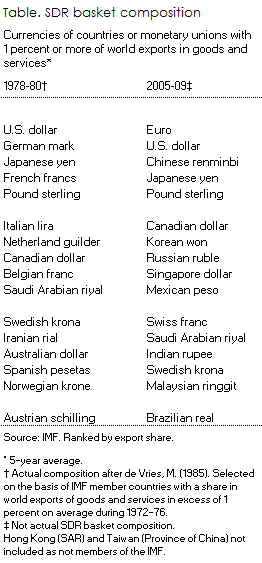2010 SDR basket review
16 November 2010
Ousmène Jacques Mandeng, Ashmore Investment Management
The IMF is working on a new SDR basket to take effect on January 1, 2011 with a decision on the new basket probably around mid- November. There are rumours that a revised SDR basket may comprise emerging markets currencies for the first time again since 1980. This would provide a strong signal that emerging markets currencies are on the rise and need to be taken seriously. It would also be illustrative of what the IMF aims to achieve with the SDRs. Following the recent promotion of SDRs through the large allocation of August 2009 and more importantly interest in the role of SDRs voiced by key emerging markets notably China and Russia, SDRs seem back from the wilderness. The SDR could thus play a more prominent role in current considerations for reforming the international monetary system. However, the IMF would have to step back decidedly from past practices and objectives to make SDRs more useful and relevant. The SDR is both a reserve asset and a unit of account. Meaningful change would mean shifting emphasis for the SDR from unit of account towards reserve asset.
The SDR is an international reserve asset created by the IMF in the 1960s in response to mounting concerns about inadequate reserve growth and hence the need to create additional reserves to supplement dollars and gold related to the so-called “Triffin-dilemma.”1 The first SDR was valued in terms of gold and was subsequently set at parity with the dollar through November 1971. With the collapse of Bretton Woods, the SDR was redefined as a basket of currencies. The original basket had 16 currencies including currencies of countries with a share of at least 1 percent in world trade. Subsequently, the number of countries was reduced to 5 in 1981 and with the introduction of the euro to 4 in 2001. Based on the existing methodology, the selection of currencies refers to the four currencies issued by countries whose exports are the largest and whose currencies are freely usable to make payments for international transactions. The weights are derived as a combination of the four currencies of the largest exporters and the share of currencies representing the main official holdings of monetary authorities’ international reserves over the past 5 years. Changes to the SDR require a decision by the IMF Board with a 70 or 85 percent majority.
The SDR represents an unconditional claim on freely usable currencies. It is neither a currency nor a liability of the IMF. SDRs are issued only by allocations to countries by the IMF in proportion to countries’ IMF quotas (there have only been 4 allocations to date). Countries have an obligation to accept SDRs; exchanges between countries though are normally voluntary. The SDR currently comprises a weighted basket of USD (44 percent), EUR (34 percent), GBP (11 percent) and JPY (11 percent). The SDR pays interest on the basis of 3-month treasury bills or equivalent of the underlying governments (3-month Eurepo in the case of the euro). The value of SDRs and its yield are not deter- mined by demand and supply but only reflect changes in the value and yields of the constituents. SDRs can de facto be used exclusively for transactions with the IMF. On 8 November, the value of an SDR was 1.5746 U.S. dollar per SDR and the SDR interest rate was 0.4 percent.
SDRs as reserve assets are of limited use by design. Today, SDRs represent only a relatively small share of total reserves of 4 percent and are held predominantly by advanced economies (IMF). The IMF wanted SDRs to be a substitute for reserve assets and be replicable in the market. However, here lies its biggest draw-back. Because it mimics existing reserves and is easily replicable, it adds no value except of course for being allocated for free; the latter is a strongly decreasing function of actual reserve holdings. The value added of the SDR could instead rest in its complementarities as a reserve asset, namely to allow central banks to gain exposure to currencies that are currently not widely used and yet set to be of increasing importance. This would apply in particular to the Chinese renminbi and Indian rupee but also other minor currencies that are already fully convertible like e.g. the Australian dollar, Canadian dollar, Mexican peso or the South African rand. The original idea of using countries or monetary unions with a share of at least 1 percent in world exports would today also produce a list of 16 currencies (Table)
